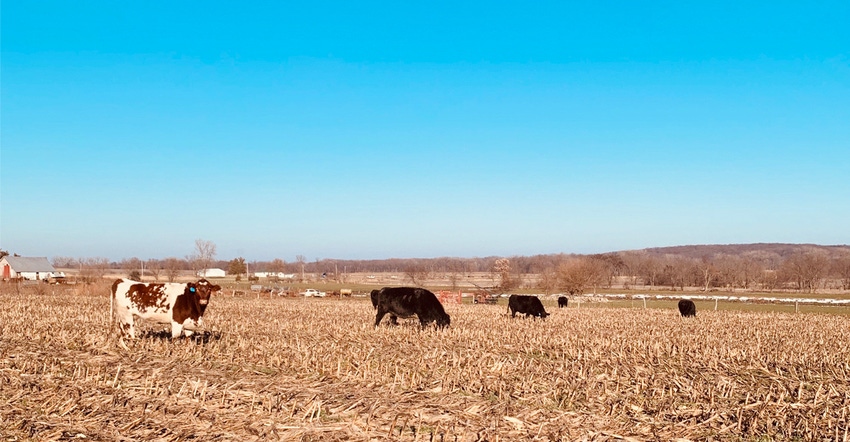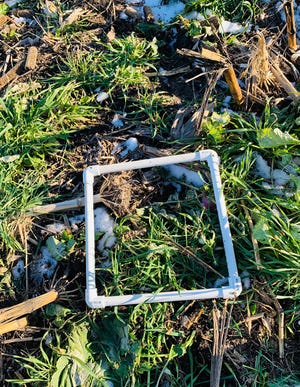October 16, 2019

By Sierra Becker
To many, the benefits of cover crops are not a secret. They can improve soil quality, suppress weeds and reduce erosion while building organic matter. For livestock farmers, cover crops can be a valuable source of forage that nourishes both animals and the land. So why don’t we see more cover crops planted each year?
The answer is cost. While research has shown that cover crops can save money in the long term, farmers are often forced to think short term. Cover crop seed and application costs are upfront expenses that many farmers can’t ignore, especially when faced with tight margins.
For livestock farmers, however, there is a way to recoup those expenses within the same year: graze the cover crop. Kurt Moffitt, a cattle and row crop farmer near Indianola in south-central Iowa, is using this strategy on his farm. He has been planting and grazing cover crops for the past five years and says the practice is benefiting both the land and his bottom line.
“We started using cover crops as an erosion control measure, and I have seen less erosion caused by big spring rains,” Moffitt says. “We are using grazing as an attempt to recapture some of the cost of seeding and terminating.”
Calculate forage value
Moffitt plants a mix of turnips and cereal rye, and can graze his beef cattle and cow-calf herd on this mix during fall and into winter. To figure out how much money he’s saving by doing this, he conducted a simple test in collaboration with Practical Farmers of Iowa to calculate the actual forage value of his cover crops:
Step 1. He and a PFI staff member clipped the ungrazed cover crop biomass inside five 1-by-1-square-foot blocks they randomly sampled from his field.
Step 2. They dried the biomass inside a paper bag for four to five days, and then weighed the biomass.
Step 3. To estimate how much dry matter an acre provides, they converted the gram weight of that biomass to pounds (divide the mass of the dry forage by 453.6 grams per pound) and multiplied that value by 8,712 (this is the number you get when you divide 43,560 — the number of square feet in an acre — by 5, representing his 5-square-foot block). A full explanation of the method is available in the Grazing Cover Crops fact sheet by PFI.
Step 4. Moffitt used Iowa State University’s Ag Decision Maker tool Economics of Cover Crops to analyze the economic benefits and costs of his cover crops, including harvesting and grazing.
With these tools, he was able to validate how many grazing days his cover crops offer, as well as how much money he’s spending and saving by grazing cover crops each year.
Fall, spring most beneficial
After drying and weighing the biomass, Moffitt found he had about 3,976 pounds of dry matter per acre. His 52 cows graze on 75 acres collectively, requiring 2,496 pounds of dry matter per day. Total dry matter intake was calculated using 4% of a cow’s body weight, which considers nutritional needs, waste and buffer.
Through the Ag Decision Maker tool, he learned that grazing cover crops is saving him $1.81 per animal unit (1,000 pounds of animals) per day.
This number was calculated based on the assumption that feeding hay instead of cover crops would have cost $100 per ton, which is conservative considering recent increases in the price of hay. Over the course of a 21-day grazing period in November 2018, the total forage value of his cover crops equaled $31.55 per acre.
 GO FIGURE: Many farmers who are grazing cover crops assume they are saving money, but their hunch doesn’t always turn out correct.
GO FIGURE: Many farmers who are grazing cover crops assume they are saving money, but their hunch doesn’t always turn out correct.

However, his seed and application costs totaled $38 per acre — and thus, his costs still exceeded what he saved by grazing at that point. To cover the remaining costs, he planned to graze cover crops in the spring, but poor weather got in the way. If he would have been able to let his cows graze the cover crops, he could have used the calculator tool to estimate grazing profitability.
For example, if he grazed his 52 cows for two weeks in April, the cover crop forage value would have been $54.08 per acre, netting him $14.58 per acre. If he grazed for the entire month of April, cover crop forage value would have been $73.61 per acre, netting him $35.61 per acre.
Moffitt followed his cover crop with soybeans, which provides a longer spring grazing window — when weather cooperates. These numbers also don’t include any cover crop cost-share assistance, which can help keep farmers profitable.
Innovating to boost profitability
For Moffitt the cost-savings picture is promising, although he admits there can be other obstacles to grazing cover crops, such as picking the best time to get the cover crop planted for maximal growth and weather-related challenges.
“Drilling after harvest doesn’t allow enough growth time for the covers to give any substantial amount of feed in the fall,” he says. “Aerial application around Labor Day into corn has given us the best results for fall growth, but only if there is a rain within a week of application. Without timely rain, stands can be insufficient.”
Motivated by the benefits of planting and grazing cover crops, he has been experimenting with different approaches, such as including two different species of cover crops in his mix. “By having two different plants, hopefully, conditions will be good for at least one of them,” he says. “We tried using only frost-killing species like oats and clover ahead of corn to eliminate the termination risk, but we never felt they gave us enough biomass to be worth the time, effort and cost.”
For now, he plans to stick with a mix of turnips and cereal rye.
Decisions based on data
Moffitt also plans to calculate the forage value of his cover crops more often, so he has a better financial picture of how cover crops are working for him.
Meghan Filbert, livestock program manager for PFI, helped create the “Economics of Cover Crops Tool” and says a key goal is to help farmers more accurately assess the value of cover crops in their systems, particularly when cover crops are used as forage.
“Farmers know how much it costs to feed hay in the winter, and how many days they need to feed hay,” she says. “But they don’t usually know what it actually costs them to establish and graze cover crops. As a result, they often overestimate the value of cover crops and can’t identify what to tweak in their management to be profitable.”
Many farmers who are grazing cover crops assume they are saving money. But since many also assume it’s too difficult to get actual data on how cover crops are performing for them, their hunches don’t always turn out to be correct.
With the steps and resources provided in this article, it’s easy for farmers to track how much it costs to graze cover crops, as well as how much money they save — and what they can adjust to boost the economic value of cover crops in their system.
Becker is a sustainable agriculture assistant with PFI.
Source: PFI, which is responsible for information provided and is wholly owned by source. Informa Business Media and subsidiaries aren’t responsible for this content.
You May Also Like




